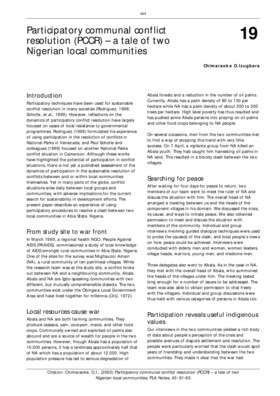Participatory communal conflict resolution (PCCR) - - a tale of two Nigerian local communities
Document begins: xxx Participatory communal conflict 19 resolution (PCCR) a tale of two Nigerian local communities Chimaraoke O.Izugbara Introduction Abala forests and a reduction in the number of oil palms. Currently, Abala has a palm density of 80 to 130 per Participatory techniques have been used for sustainable hectare while NA has a palm density of about 200 to 550 conflict resolution in many societies (Rodriguez, 1998; trees per hectare. High level poverty has thus resulted and Schotle, et al., 1999). However, reflections on the has pushed some Abala persons into preying on oil palms dynamics of participatory conflict resolution have largely and other food crops belonging to NA people. focused on cases of local resistance to governmental programmes. Rodriguez (1998) formulated his experience On several occasions, men from the two communities met of using participation in the resolution of conflicts in to find a way of stopping this trend with very little National Parks in Venezuela, and Paul Schotle and success. On 7 April, a vigilante group from NA killed an colleagues (1999) focused on another National Parks Abala youth. They had caught him harvesting oil palms in conflict situation in Cameroon. Although these works NA land. This ...
Cite this publication
Available at https://www.iied.org/g01991
